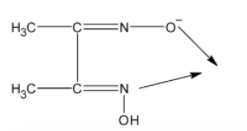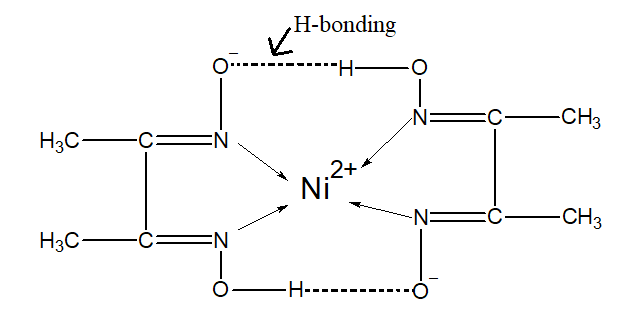
Dimethylglyoxime is an example of a:
A) Monodentate ligand
B) Bidentate ligand
C) Tridentate ligand
D) Hexadentate ligand
Answer
221.1k+ views
Hint: In the coordination compound, the neutral molecules or ions bound to the central atom or ion in the coordination entity are called as a ligand. The dmg is a ligand and it has the oxygen and the nitrogen as the donor atom. This atom can donate their electron to the metal resulting in the formation of a coordinating complex.
Complete step by step solution:
The ligand can be defined as the molecule or ion which is capable of donating a pair of electrons to the central metal or ion to form a coordinate bond with it.
The number of coordinating ligating groups which are present on the ligand is called the denticity of the ligand.
The ligand can be unidentate, bidentate, or polydentate depending on the size of the donation. Ligands that have the two donor atoms and therefore can coordinate to the central ion at two positions are called the dentate or bidentate ligand.
The dimethylglyoxime acts as the ligand. It is also abbreviated as dmg or DMG. The structure of the dimethylglyoxime is as shown below:

In a basic medium, one of the hydroxyl groups gets deprotonated leaving behind a ${{\text{O}}^{-}}$. The oxygen acquires the extra pair of electrons thus it can act as a ligand. Similarly, the nitrogen on the other hand has an electron pair. Thus it acts as the electron donor. The dmg in the basic medium is as shown below:

Thus dimethylglyoximato has two donor sites therefore dmg is a bidentate ligand.
Hence, (B) is the correct option.
Additional information:
The DMG forms a complex with nickel. It is a red colour complex which is formed in the basic conditions. The nickel can acquire the eight electrons thus two dimethyl glyoximato ligands arranged around the nickel atom. The dmg ligands are stabilized by hydrogen bonding. The nickel –dmg complex is as follows:

Note: The dmg is also a chelating agent. It means that the ligand uses its two or more donor atoms to bind the same central atom. The two dmg ligands donate their electron to the metal and form the metal complex.
Complete step by step solution:
The ligand can be defined as the molecule or ion which is capable of donating a pair of electrons to the central metal or ion to form a coordinate bond with it.
The number of coordinating ligating groups which are present on the ligand is called the denticity of the ligand.
The ligand can be unidentate, bidentate, or polydentate depending on the size of the donation. Ligands that have the two donor atoms and therefore can coordinate to the central ion at two positions are called the dentate or bidentate ligand.
The dimethylglyoxime acts as the ligand. It is also abbreviated as dmg or DMG. The structure of the dimethylglyoxime is as shown below:

In a basic medium, one of the hydroxyl groups gets deprotonated leaving behind a ${{\text{O}}^{-}}$. The oxygen acquires the extra pair of electrons thus it can act as a ligand. Similarly, the nitrogen on the other hand has an electron pair. Thus it acts as the electron donor. The dmg in the basic medium is as shown below:

Thus dimethylglyoximato has two donor sites therefore dmg is a bidentate ligand.
Hence, (B) is the correct option.
Additional information:
The DMG forms a complex with nickel. It is a red colour complex which is formed in the basic conditions. The nickel can acquire the eight electrons thus two dimethyl glyoximato ligands arranged around the nickel atom. The dmg ligands are stabilized by hydrogen bonding. The nickel –dmg complex is as follows:

Note: The dmg is also a chelating agent. It means that the ligand uses its two or more donor atoms to bind the same central atom. The two dmg ligands donate their electron to the metal and form the metal complex.
Recently Updated Pages
The hybridization and shape of NH2 ion are a sp2 and class 11 chemistry JEE_Main

What is the pH of 001 M solution of HCl a 1 b 10 c class 11 chemistry JEE_Main

Aromatization of nhexane gives A Benzene B Toluene class 11 chemistry JEE_Main

Show how you will synthesise i 1Phenylethanol from class 11 chemistry JEE_Main

The enolic form of acetone contains a 10sigma bonds class 11 chemistry JEE_Main

Which of the following Compounds does not exhibit tautomerism class 11 chemistry JEE_Main

Trending doubts
JEE Main 2026: Application Form Open, Exam Dates, Syllabus, Eligibility & Question Papers

Derivation of Equation of Trajectory Explained for Students

Hybridisation in Chemistry – Concept, Types & Applications

Understanding the Angle of Deviation in a Prism

How to Convert a Galvanometer into an Ammeter or Voltmeter

Degree of Dissociation: Meaning, Formula, Calculation & Uses

Other Pages
NCERT Solutions For Class 11 Chemistry Chapter 7 Redox Reaction

JEE Advanced Marks vs Ranks 2025: Understanding Category-wise Qualifying Marks and Previous Year Cut-offs

Hydrocarbons Class 11 Chemistry Chapter 9 CBSE Notes - 2025-26

Thermodynamics Class 11 Chemistry Chapter 5 CBSE Notes - 2025-26

NCERT Solutions ForClass 11 Chemistry Chapter Chapter 5 Thermodynamics

Equilibrium Class 11 Chemistry Chapter 6 CBSE Notes - 2025-26




